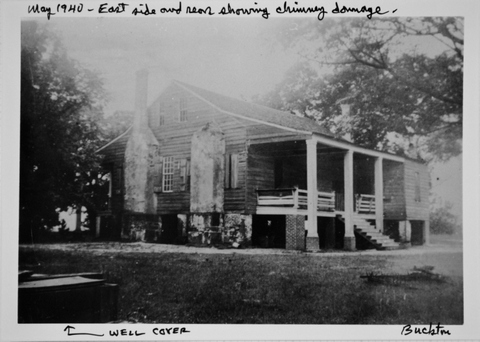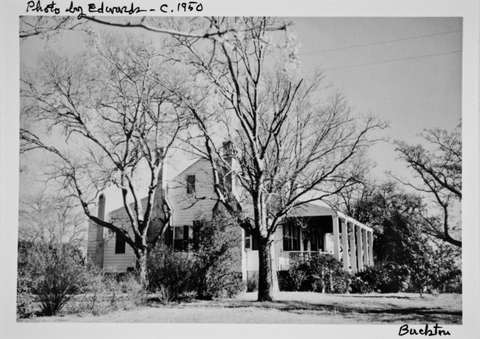“A small but exquisite plantation home – restored to perfection by preservation architect, Mr. Henry Boykin.”
City Directories and History: Buckton is said to have been built in circa 1798 by General Zachariah Cantey and his wife Sarah Boykin. However, another account suggest that their original home burned and this house was built as late as 1810. At Zachariah’s death in 1822 the property was divided among his four children.
The Zachariah Cantey House is believed to have been built for Zacariah Cantey ca. 1795. The house is a fine example of a rural upcountry South Carolina planter’s residence with notable Federal detail. The house is a rectangular, one-and-one-half story hall and parlor residence with a hewn-timber braced frame and beaded weatherboard siding. The house has a tall,  brick pier foundation and a gable roof. A one-story shed roofed, recessed, porch supported by six freestanding wooden pillars shelters the façade. The high quality of the interior woodwork is matched by the craftsmanship in the structure and sheathing of the house. The property is also significant for its association with Zachariah Cantey, a prominent local planter, businessman, and politician. Cantey served as quartermaster under General Greene during the Revolution. He was appointed brigadier general of the South Carolina Militia, 8th Brigade. Cantey served as commissioner to provide for exportation of beef at Camden, commissioner for inspection of bread and flour at Camden, commissioner to improve navigation of the Wateree River, commissioner of roads, and commissioner for opening the Wateree River. He was an incorporator of the Pine Tree Navigation Company, president of the Camden Jockey Club, incorporator of Camden Episcopal Church and a trustee of the South Carolina College. He also served in the State Senate. Listed in the National Register May 19, 1983. [Courtesy of the SC Dept. of Archives and History]
brick pier foundation and a gable roof. A one-story shed roofed, recessed, porch supported by six freestanding wooden pillars shelters the façade. The high quality of the interior woodwork is matched by the craftsmanship in the structure and sheathing of the house. The property is also significant for its association with Zachariah Cantey, a prominent local planter, businessman, and politician. Cantey served as quartermaster under General Greene during the Revolution. He was appointed brigadier general of the South Carolina Militia, 8th Brigade. Cantey served as commissioner to provide for exportation of beef at Camden, commissioner for inspection of bread and flour at Camden, commissioner to improve navigation of the Wateree River, commissioner of roads, and commissioner for opening the Wateree River. He was an incorporator of the Pine Tree Navigation Company, president of the Camden Jockey Club, incorporator of Camden Episcopal Church and a trustee of the South Carolina College. He also served in the State Senate. Listed in the National Register May 19, 1983. [Courtesy of the SC Dept. of Archives and History]
Buckton is listed on the National Register, as of 1983 and has been recognized for the outstanding gardens of long-term owners Mr. and Mrs. Henry Boykin, one of S.C.’s premier preservation architects. In 2013, at a meeting with R&R’s founder, W.B. Fairey, Sr., Mr. Boykin stated he felt R&R’s name “The Carolina Rain Porch“ describing the detached columned porches used prevalent across S.C., was the most appropriate name he had ever encounter. From this time forth, he declared, that should be the appropriate architectural term used for the porch style.
Further information: The Zachariah Cantey House, located in rural Kershaw County, is believed to have been built for Zachariah Cantey ca. 1795. The house is a fine example of a rural upcountry South Carolina planter’s residence with notable Federal detail. The property is also significant for its association with Zachariah Cantey, a prominent local planter, businessman, and politician. Additional Information: Family and local tradition suggests that this house was constructed for Zachariah Cantey probably before 1800, when he is listed as a head of household for the first time in the census records. Although it cannot be documented exactly when Cantey acquired this piece of land, it is known that he owned great quantities of land in the immediate vicinity which likely included this site/ Cantey was born in 1759 in Camden District. He married Sarah Boykin, probably about 1792. Sarah’s father’s will of 1791 lists Zachariah Cantey as executor of his estate but seems to indicate that Sarah was not married. In addition, Zachariah and Sarah’s oldest child, Zachariah, Jr., was a student at the South Carolina College by 1806. Zachariah Cantey was very active in the affairs of his district and state. He served as quartermaster under General Greene during the Revolution. He was appointed brigadier general of the South Carolina Militia, 8th Brigade. Cantey served as commissioner to provide for exportation of beef at Camden, commissioner for inspection of bread and flour at Camden, commissioner to improve navigation of the Wateree River, commissioner of roads, and commissioner for opening the Wateree River.
He was also an incorporator of the Pine Tree Navigation Company, president of the Camden Jockey Club, incorporator of Camden Episcopal Church and a trustee of the South Carolina College. Cantey served in the State Senate from Lancaster and Kershaw from 1804-1808. He was also a successful planter and merchant. Zachagiah Cantey died in 1822; his estate, however, was not settled until 1832. The property remained in the Cantey family at least until 1877. It is not known exactly when the property became known as Buckton, but that name is recorded by 1874. NR File Data / SC Dept. of Archives and History
Stay Connected
Explore history, houses, and stories across S.C. Your membership provides you with updates on regional topics, information on historic research, preservation, and monthly feature articles. But remember R&R wants to hear from you and assist in preserving your own family genealogy and memorabilia.
Visit the Southern Queries – Forum to receive assistance in answering questions, discuss genealogy, and enjoy exploring preservation topics with other members. Also listed are several history and genealogical researchers for hire.
User comments welcome — post at the bottom of this page.
Please enjoy this structure and all those listed in Roots and Recall. But remember each is private property. So view them from a distance or from a public area such as the sidewalk or public road.
Do you have information to share and preserve? Family, school, church, or other older photos and stories are welcome. Send them digitally through the “Share Your Story” link, so they too might be posted on Roots and Recall.
User comments always welcome - please post at the bottom of this page.

![Image by Gill Swift in the spring of 1942 – [Courtesty of the Camden Archives and Museum]](https://www.rootsandrecall.com/camden/files/2013/08/th_35daec7018489a4d3b823df8bdea5fee_1468256078DSC_00070021942BuckstonPlantationCompressed.jpg)







My ggggrandfather and mother’s plantation home.
I have no idea if anyone will see this or reply back, but the spelling on your website of ‘Buckston Plantation’ is incorrect, there is no ‘s’: it is Buckton plantation. My grandfather is Henry D. Boykin, the architect and I’m sure if he were still with us, he’d want me to reach out and make sure it was spelled correctly, as he was a very dedicated historian. Thanks for your time and email back if you have any questions.